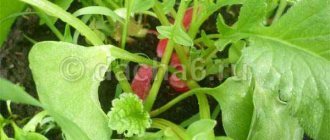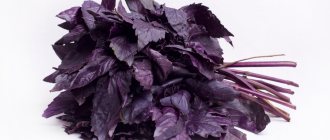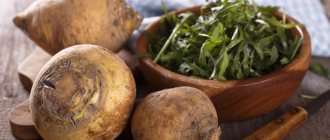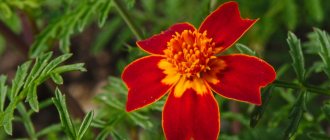Preparing a site for planting cilantro
Preparatory work begins two weeks before planting. They determine the location, analyze the composition of the soil, remove roots and all plant debris. If the predecessor crop suffered from fungal diseases, treat the soil with a fungicide.
Priming
During the pre-sowing tillage period, it is worth analyzing its mechanical composition and acidity level. Coriander develops and ripens normally, giving a good harvest, on light, loose soil.
Light loams and sandy loams are ideal. The structure of heavy soils needs to be worked on when preparing beds for planting. Add sand, peat, compost. The proportions and type of additive depend on the quality of the soil in the garden. Depleted soil is enriched:
- organic matter (0.5 buckets per 1 m²);
- superphosphate (1 tsp);
- potassium nitrate (1 tsp).
The acidity level of coriander is important. It grows well if the soil is neutral or moderately acidic.
Illumination of the area
Lighting directly affects the content of essential oils in fruits. Coriander is a crop that needs light for full development. When planting in the shade:
- fruits ripen slowly;
- the harvest is small;
- the percentage of essential oil in the seeds is low.
A sunny area is a prerequisite for getting a good harvest. Lowlands are not suitable for planting, especially when sowing seeds before winter. Before they have time to rise, they will get wet. It is preferable to cultivate the crop on flat and elevated surfaces.
Cilantro plant - planting and first care of seedlings
Cilantro is planted mainly in the first weeks of spring, so preparation begins in late autumn. You cannot do without deep plowing and good loosening of the soil immediately after frost, so that there is a kind of “cushion”. Fertilizers are the key to an excellent spice harvest. You will need 200 kg of superphosphate and potassium salt per 1 hectare of area, as well as 150 kg of ammonium nitrate. Fertilize twice a season so that the grass grows large and does not enter the stemming stage.
The best predecessors are annual grasses, legumes and wheat. It is not recommended to plant kishnish after sunflower, pumpkin, cabbage, beets and corn. The bed should be loosened in the spring to a depth of 20 centimeters, after which sowing is carried out to 2-3 centimeters (more is not possible, since the plant has very little vitality). The best time for sowing is April 21-29. In order to provide yourself with tasty herbs throughout the season, you need to sow every 15-20 days so that you have several stages of ripening of spices.
Row spacing is at least 15 centimeters; 1.8 million seeds are planted per hectare. After planting, it is best to use rollers to compact the soil a little. Abundant watering is required. Before planting, it is necessary to soak all seeds in a growth stimulator for 8-12 hours - this increases germination by 25%. After successful shoots have been obtained, periodically loosen the soil, preventing it from drying out and forming a crust.
Predecessors
Any garden crop to which organic matter has been added will be a good predecessor to coriander. The spice feels great after cucumbers, all types of legumes, cabbage and potatoes. The aromatic herb goes well with spicy herbs (cumin, anise) and has a good effect on the growth of vegetables (cucumbers, zucchini, cauliflower).
Coriander varieties
Massive cultivation of coriander is carried out in the North Caucasus, Ukraine and the southern regions of the Russian Federation. Amateur gardeners plant cilantro everywhere; its fragrant greens can be found among summer residents of Yakutia. When choosing a variety, you need to carefully read the description.
Vegetable varieties are used for greens; they bloom late. Early ripening varieties that quickly enter the flowering period are sown for harvesting seeds and preparing essential oil.
Popular vegetable varieties of cilantro
Vegetable varieties include varieties of coriander in which flowers form later, this allows you to get more greenery for cutting. The following varieties are considered popular among summer residents:
- Amber;
- Borodinsky;
- Taiga.
Amber is good for its late bolting and early abundant greenery. Cutting can be done a month after germination. Borodinsky coriander delights summer residents with its juicy, aromatic leaves. It can be used for greens after 1-1.5 months, and seed ripening occurs after 90 days.
Taiga is a very popular variety with a late ripening period. Like cilantro, you can use it after 1-1.5 months. The leaves are brightly colored, thick, fragrant. They serve as an excellent addition to various dishes.
Varieties of obtaining coriander
To obtain coriander seeds, you can sow any variety. When planted in autumn, seedlings appear early, and the fruits ripen successfully in all weather conditions. To obtain spices early, you can sow the early ripening Debut variety, its characteristics:
See also
Description of the coriander variety Caribe, features of cultivation and careRead
- ripens in 1.5 months;
- rosette height 29 cm;
- socket weight 25 g.
The good thing about this variety is that in a short time you can get greens for meat and fish dishes, as well as spicy seeds for adding them to sauces, baked goods, and marinades.
It is worth paying attention to the mid-season variety Stimul. It can be sown before winter or early spring. It forms well-leafed rosettes weighing up to 45 g. The ripened fruits make an excellent seasoning. Stimul is also suitable for harvesting greenery; it can be sown every 2 weeks until July 15 and cut after 1-1.5 months.
Coriander sativum - a brief description and the most famous varieties
Cilantro is an annual plant that is used as a seasoning for hundreds of different dishes, and is an indispensable ingredient in the preparation of sauces, salads, soups, stews and the like. Kishnets (the old Russian name for coriander) has increased frost resistance and can easily tolerate temperatures down to -20 degrees on soil even without snow. But it is very difficult to grow - it is picky about the composition of the soil and with the slightest lack of the minerals it needs, it grows very small or disappears altogether.
Morphology. The plant is relatively tall, the stems can reach 90-130 centimeters in height if the kolyandra (as they say in Belarus) is watered abundantly and a little nitrogen fertilizer is added to the soil. It is of high value for culinary purposes in the first months of growth, when the stems have not yet fully formed and the leafy part can be cut along with them. Afterwards, when the shoots have become stringy, only the tops (aka umbrellas) are used. Small white flowers with pale sepals perfectly decorate the garden bed. Today, more than 50 types of sowing kishnisha (as this greenery is called in Turkey and Azerbaijan) are grown in Russia. The most famous variety is Long Stand RS. It stays in the grass stage for a very long time and is in no hurry to start stemming. There are also other varieties, they are less known, but have very good taste.
- Amber. The ripening period is 85-98 days from the moment of planting, it enters the stemming phase after 2 months, has a very fragrant smell, and in the early stages the taste is inferior to other varieties. Productivity up to 15 c/ha with good care, essential oil content – 3%. Recommended for cultivation in the North Caucasus region, but bears fruit very well in the temperate climate zone in southern Russia.
- Caribe 215. One of the most famous hybrids of seed kashnich (this is what the Uzbeks call coriander), produces up to 20 c/ha, while the essential oil content is up to 3.5%. The ripening period is much shorter than that of its main competitors - only 65-76 days from the moment of planting in the soil. It was originally grown in Holland, but today it is an industrial crop in many regions of the Russian Federation. It is in great demand among farmers, since the stemming phase begins almost at the stage of biological ripeness of the plant.
- Alekseevsky 190. Another hybrid of coriander, which was already bred at the breeding site in Krasnodar. Excellent for growing in our latitudes, tolerates severe frosts and is resistant to pests.
- Chilantro (the name comes from British coriander lovers) must be grown only on light soils, mainly sandy loam, since the root system of the plant is very sensitive to a lack of oxygen and increased soil density. Soil acidity should be minimal; it is best to reduce it with construction chalk (1 kg per 1 square meter of area). It is necessary to sow into the soil as soon as possible. The bushes are not afraid of frost and, if sown in spring, can withstand any bad weather.
Sowing cilantro seeds in open ground
Growing a good harvest from quality cilantro seeds is not difficult. This culture does not require complex technologies. Most gardeners practice planting with dry seeds (before winter, early spring) or treated with growth stimulants (spring, summer).
To obtain early production, they are propagated by seedlings. Sowing of seedlings is done in February, using separate cups and boxes for seedlings. The soil is taken from the garden. Grown rosettes are planted in open ground when frosts have passed and the soil has warmed up. If there is a threat of return frosts, the seedlings are covered with covering material at night.
Popular vegetable varieties of cilantro
For collecting cilantro, preference is given to vegetable varieties. They have delicate green leaves that are distinguished by their rich aroma:
- Avangard is a small bush, richly colored greens, has a bright spicy aroma, and can be grown indoors. The first cutting of cilantro is done after 45 days.
- Caribe - blooms mostly late, the leaves have a delicate taste and intense aroma.
- King of the market - this species is characterized by early ripening, has a large proportion of foliage, very juicy and delicate in taste.
- Borodinsky is a bush up to 65 cm, compact in size, and has an average ripening period. Having a delicate flavor, greens are perfect for salads. Cilantro is grown exclusively in open ground. Harvesting takes place already on the 35th day.
- Taiga is a low bush with abundant greenery. Ripens late, harvested after 45 days.
- Picnic - has an early ripening period. The foliage has a spicy taste and rich aroma. Suitable for growing at home.
Varieties of obtaining coriander
If seeds are important when growing, you should give preference to varieties that produce a high-quality coriander harvest:
- Amber is a bush with abundant foliage and a delicate flavor. Releases the arrow late. The seeds are characterized by a rich spicy aroma and are used in baking and cooking meat.
- Venus is a type of crop that has abundant greenery; the seeds have a mild piquant aroma.
- Alekseevsky - has an average ripening period, blooms late, the variety is resistant to low temperatures.
- Debut - has early seed ripening, ready in 45 days, grows up to 25 cm in height.
- Stimul is a medium-ripening variety, suitable for sowing before winter.
See also
How to grow coriander (cilantro) from seeds in winter on a windowsill in an apartment at home
Read
Sowing cilantro seeds in open ground
Some gardeners grow cilantro from ordinary seeds. Coriander seeds are simply sown in the ground and covered with soil using a rake. Later you get lush, good greens. This proves that cilantro is not a very demanding crop. But such cultivation only produces greens. To get an abundant, high-quality harvest of not only cilantro, but also seeds, it is necessary to adhere to a different growing technology. Special rules for planting seeds have been developed.
For early harvesting, it is recommended to plant in a greenhouse, under film or greenhouse.
To get early cilantro and seeds, it is recommended to propagate by seedlings. Seeds for seedlings are sown at the end of winter; cups and boxes for seedlings are used for this. The soil can be taken from the garden.
Sprouted plants are planted in open ground after frost, when it warms up. If there is a threat of repeated frosts, caring for seedlings involves covering them with film.
Coriander planting dates
When choosing a variety, you need to pay attention to the characteristics and ripening period. You can grow coriander for an early harvest by sowing early-ripening varieties; their seeds ripen in 30 days. Harvesting of mid-ripening varieties begins after 35-40 days, late-ripening varieties - after 45-50 days.
Planting dates depend on the variety and weather conditions. You can sow in open ground before winter and from April to July. If the main purpose of planting is to obtain greenery, then from April to mid-July cilantro is sown every 2 weeks.
Caring for coriander plantings
The spicy-fragrant crop does not require attention from the gardener; caring for the plantings is simple - you need to systematically remove weeds, loosen the soil and water in a timely manner. However, in order to reap a good harvest, you need to follow certain agrotechnical recommendations. After planting coriander and sprouting, caring for it in open ground includes the following measures:
- Thinning seedlings - in order for plants to develop and produce a good harvest, they need enough space; there should be a distance of 6-9 cm between individual specimens.
- Watering - if the soil is not sufficiently moistened, the plant will begin to shoot arrows. Before the seedlings appear and 2 pairs of true leaf blades develop, water at the rate of 3-5 liters of water per m² of planting. During active collection of green mass, the volume is increased to 8 liters per m². When the seeds begin to ripen, the soil is moistened less, reducing the volume of water to 2 liters per m² of planting. When the weather is rainy, watering is reduced completely and resumed only after the top soil layer has dried.
- Fertilizing - before sowing, enrich the soil with potassium-phosphorus preparations and humus. Before germination, it is permissible to water the plantings with a urea solution (1 tablespoon per 10 liters of water). After the seedlings appear, coriander is no longer fed.
- Loosening - combined with the removal of weeds, done at least once a week, using a flat cutter.
Cilantro is not very susceptible to diseases, but in the case of a rainy summer and heavy morning dew, the plantings may be affected by ramularia. The first sign of the disease is brown marks on the foliage. When bushes become infected with ramularia during the flowering phase, the yield drops by 80%. Also, due to high humidity, coriander sometimes gets powdery mildew - a whitish coating appears on the ground part. To cure, you need to treat the bushes with a fungicide, but you cannot harvest until the drugs used stop working. Of the harmful insects whose problem is solved with insecticides (Actellik and similar preparations), coriander is attacked by the following:
- seed eaters;
- bedbugs;
- fall armyworm;
- wireworm;
- umbrella moth.
Attention!
Coriander is not treated during the flowering phase, since the plant is a honey plant.
How to collect seeds
The seeds begin to ripen at the end of August. The harvesting period lasts until mid-September. If you do not remove all the plants, then next year the seeds that fell into the ground will germinate. This must be taken into account when harvesting. Coriander is a cold-resistant crop and reproduces by self-sowing even in Siberia.
The readiness of seeds for harvesting is determined by their color. You can start harvesting when 60% of all fruits acquire a brown-brown color. In the morning or evening, the bushes need to be cut at ground level, collected in bunches and dried in a suspended state in the shade (attic, barn, shed). You can thresh the seeds after 7-10 days and use them in cooking or for autumn-spring planting.
Pre-sowing seed preparation
For planting, use ripened seeds that have not expired. Germination persists for 2 years. Sowing is carried out with dry seeds; they do not require additional processing. All pre-sowing treatment comes down to visual inspection and rejection of unripe seeds; they can be easily distinguished by their smell, which resembles the smell of bedbugs.
When to sow coriander
In greenhouses, the first sowing is carried out in February or March, the exact period depends on the soil and air temperature. You can expect the appearance of flower stalks on the 40th day after the sprouts appear. With later sowing (May, June), flowering occurs earlier.
For sowing crops by seed, the ideal time for planting in open ground is early spring or autumn. With late sowing, the number of seeds decreases and the volume of greenery increases. Cilantro is a plant with long daylight hours, and when daylight hours decrease (July-September), plant growth slows down and the number of shoots decreases.
How to sow cilantro in open ground
Recommended seed consumption is 1.5 g/m². You need to plant to a depth of 1.5-2 cm. Different sowing methods are allowed:
- into the furrows;
- scattered;
- into the hole.
When planting in rows, maintain an interval of 15 cm between lines. When planting scattered, 2.5 g of seeds are randomly scattered over 1 m². The holes are formed, observing a step of 10-15 cm, 3 seeds are placed in each. The soil must be moist before sowing.
See also
How to properly grow cilantro in a greenhouseRead
Features of planting before winter
The timing of planting cilantro before winter depends on the region, usually it coincides with the end of Indian summer. Warming may cause seeds to germinate, which is not desirable. In autumn, the usual planting methods are used, the same as in spring and summer. The main difference is dry soil. The furrows are not watered before planting.
Care
Care when growing for seeds and greens is the same: removing weeds, loosening the rows, watering and periodic thinning. Planting in rows with optimal row spacing makes maintenance easier. At the same time, you can remove weeds and loosen the soil using garden tools (flat cutter, ripper).
Thinning the sprouts
As seedlings appear, it is necessary to monitor their density. Without thinning, if planted tightly, the plants will be weak with few leaves and seeds. Thinning of crops is carried out periodically, maintaining an interval between seedlings of 6-9 cm.
Features of watering
Soil moisture affects product quality. A common reason for early bolting of coriander is a prolonged lack of moisture in the soil. Moist and loose soil is the main condition for growing lush greens. During rains, watering is stopped as there is enough natural moisture in the soil.
| Growth phase | Consumption per 1 m² |
| Before and after emergence | From 3 to 5 l |
| Active growth of the above-ground part | 8 l |
| Seed ripening | 2 l |
Care
It will be necessary to carry out many agrotechnical measures so that coriander grows normally for greens or seeds. Weeds can be destructive to cilantro that is not yet strong enough, so you need to remove it in time.
After the plant reaches five centimeters, it will need fertilizing with nitrogen fertilizer. Now you need to mulch the soil, which will slow down the growth of weeds and maintain moisture during cultivation.
Thinning the sprouts
Not every cilantro will exhibit ideal health and potential when grown. This is why it is so important to periodically thin out the garden bed to remove weak plants. The latter, at times, can be good for food.
Features of watering
Much attention is paid to the plant obtaining moisture. This is a necessary condition for succulent foliage. From 3 to 4 liters of water per square meter is used for seedlings, while during the active growth phase of the crop, 8 liters per meter will be needed.
If cilantro does not receive the required amount of water, the plant will begin to shoot arrows, and the leaf rosette will form poorly. So, at the first sign, the volume of water used for irrigation is urgently clarified and, possibly, revised.
Rules for feeding coriander in the garden
When growing cilantro, basic fertilizers are applied before planting. However, fertilizing may come in handy. As such a fertilizer, some kind of fertilizer containing nitrogen is used. It should be used after the cilantro is 5 centimeters in height.
Diseases and pests
The most common diseases during cultivation are powdery mildew and ramularia. To prevent the plant from encountering such a problem, waterlogging should not occur. In addition, with improper planting practices, the risks of these diseases increase.
If the crop does encounter one or another disease, the already affected areas are removed so that the disease does not spread. In addition, they are treated with a fungicide, that is, a drug that kills microscopic fungi, because the latter cause these diseases. In the case of such treatment, coriander cannot be cut during the period of action of the fungicide.
As for pests, there are many of them. They are all insects:
• wireworm;
• seed eater;
• umbrella moth;
• different types of bedbugs;
• winter armyworm.
To cope with such problems when growing cilantro, you will need to treat with an insecticide. In this case, as in the case of a fungicide, great attention should be paid to the choice of drug. It is worth reading the composition, description and various reviews, including from professionals, in order to purchase the safest option.
Rules for feeding coriander in the garden
When growing coriander, all fertilizers are applied before planting. When planting before winter, humus and mineral fertilizers containing potassium and phosphorus are added to the soil before digging. In the spring, before germination, the soil can be watered with a liquid urea solution of a standard concentration of 1 tbsp. l. on a bucket. On well-fertilized soil, coriander grows without additional fertilizing.
Selection of location - preparation of soil and beds
Coriander grows well on loamy and sandy soils with a moderately acidic or neutral reaction. When the soil is heavy, peat (lowland), sand or compost is added to it. The place should not be in a lowland - the plant cannot develop in conditions of high humidity and gets wet before it ripens. It is better to plant cilantro in an area that is lit all day, and where the following crops were previously grown:
- potato;
- cabbage;
- green peas and other legumes;
- cucumbers
Coriander should be planted in previously dug soil to a depth of 20-28 cm. If the soil is not nutritious enough, it is fertilized during digging. To do this, use organic matter (5 liters per m²), urea (1 tablespoon per 1 m²) and superphosphate (20-30 g per 1 m²). Also, before planting cilantro, it is recommended to water the prepared area with a strong pink solution of potassium permanganate.
Diseases and pests
There are not many diseases that affect cilantro plantings, but during periods of prolonged rains and frequent dew in the morning, you can be left without a harvest. The cause may be ramulariasis of coriander. Pathogens can infect the plant throughout the entire growing season.
The first signs of ramulariasis appear on the leaves (brown spots).
Further development of the disease is accompanied by damage to the entire above-ground part: stems, umbels, buds, flowers, fruits. If the period of illness coincides with the flowering of coriander, then up to 80% of the harvest is lost. Before the formation of stems and the appearance of buds, plantings can be treated with fungicides. During flowering, all treatments are stopped, since the plant is a good honey plant.
With increased soil and air humidity, cilantro can be affected by powdery mildew. The fungus affects the above-ground part. When the first symptoms (white plaque) appear, you can use the traditional method - treat the plants with a soap-soda solution. When using chemicals, greens should not be eaten while the effect of the drug lasts. Pests to watch out for:
- bedbugs;
- seed eaters;
- winter cutworm;
- umbrella moth;
- wireworm.
Harvesting cilantro
Cilantro is grown for fresh consumption, drying, and freezing. It is necessary to sow the seeds several times during the summer in order to get 2 or more crops from one plot. The greens grow quickly and are suitable for eating and harvesting before flowering. To harvest greenery, use a sharp garden knife, cutting it 2-3 cm from the ground.
Important! In order for the plant to produce new greenery, you need to cut off the upper leaves, leaving the entire lower part of the coriander intact.
Dry the herbs in the shade. Store in crushed form. Use hermetically sealed containers. Dry cilantro retains its beneficial properties and essential oils for no more than a year. Frozen greens last longer (2 years). Before freezing, it is washed, dried, crushed and scattered into containers.
The cilantro (coriander) harvest will be excellent if all recommendations for choosing a planting site, soil preparation and care are followed. There will be fresh, aromatic herbs on the table all summer long for fish, meat and other dishes, and from August to September you can collect coriander seeds.
Harvesting and storage
After a month, the first harvest in the form of young shoots with an amazing aroma and a whole list of vitamins can be cut. General rule: cutting is carried out when the shoots do not exceed 15 cm in length. Otherwise, the branches begin to taste bitter. If more than a third of the plant is removed, its growth stops. Shoots are harvested at a time depending on the ripeness of the variety.
Cilantro seeds are collected in late summer and early autumn. Ripe fruits have a pleasant smell, while raw ones have a repulsive smell, reminiscent of a bug. They are laid out in a thin layer in a dry, ventilated place until the top shell is completely dry. Green mass can be prepared in different ways, and not just dried in the same way as seeds:
- put in a plastic container in the refrigerator - it can be stored for up to a month;
- to freeze.
For your information!
When dry, the spice is stored in a tightly sealed container.
It is not difficult to obtain juicy greens and coriander seeds: planting and caring for it in the open ground comes down to standard measures - site preparation, regular watering, fertilizing, weeding. And after 30-50 days, the gardener will be able to add nutritious shoots rich in vitamins and minerals to the salad.











